Engineering Education – Week 9.1 – Reading Notes
Reading:
Ambrose, 2010, “How Learning Works”
“Conclusion: Applying the Seven Principles to Ourselves” and “Appendices”
Summary:
Loved the very practical and direct appendices and the acknowledgment of how complex (but not impossible) to teach well and considerately. Some of the strategies are quite simple to implement but with potentially great impacts for the learning and quality of work produced by the students.
Notes:
- Teaching is complex
- “To develop mastery in teaching, we need to acquire its component skills, integrate them, and apply them appropriately. Of course, this requires that we first unpack the multifaceted task of teaching.” (Ambrose, 2010)
- Formative feedback is essential
- Strategies:
- Student Self-Assessment
- Ask directly what they know or do not know
- Concepts Maps
- Good to find out about prior-knowledge
- Rubrics
- Makes clear what is being assessed and what is expected
- Learning Objectives
- Student-centered
- Break down task into cognitive processes
- Use action verbs
- Measurable
- Ground Rules
- Maintain productive course climate
- Exam wrappers
- Reflection post-exams
- Identify own strengths and weaknesses
- Reflect on how they prepared
- Characterize nature of own errors
- Reflection post-exams
- Checklists
- Guide students when completing assignments
- Reader Response / Peer Review
- Students learn in the process
- Wider audience might motivate to produce better work
- Teacher gets better quality work in the end
- Student Self-Assessment
Engineering Education – Week 8.2 – Reading Notes
Reading:
Ambrose, “How Learning Works.”
Chapter 7: “How do Students Become Self-Directed Learners?”
Summary
Growth mindset keeps coming to mind obviously, along with the notion that metacognition must be taught starting much earlier than college. But to do so, one must focus on first teaching it to the professors and teachers, who most likely were never taught the topic either. Beyond simply teaching about it, one must recognize that self-monitoring, self-evaluating, planning and so on, are cognitively demanding tasks that must come with high motivation to be adopted by someone who is already overloaded with their practice, research, and work. The same applies to the students who on top of learning the content, they must also think about their own learning. Therefore, we should strive to reduce the load of useless-once-memorized-its-lost content and increase the load of preparing children and young adults to learn and function in real life.
Notes
- Metacognition
- “Metacognition refers to “the process of reflecting on and directing one’s own thinking” (National Research Council, 2001, p. 78).”
- Students often do not know how to evaluate their own performance
- Not a subject that is included in classrooms
- How to become a self-directed learners
- “Principle: To become self-directed learners, students must learn to assess the demands of the task, evaluate their own knowledge and skills, plan their approach, monitor their progress, and adjust their strategies as needed.” (Ambrose, 2010)
- Cycle of Self-Directed Learning
- Not really a core-loop, more like a challenge-loop
- Assessing the task is actually quite hard to be done by students
- Evaluating personal performance is done poorly by low performing students
- Planning, if done at all, is done poorly by low performing students
- Apply Strategies and Monitor Performance your own behavior increases learning
- Reflecting on approach taken may not lead to trying another strategy
- Student’s beliefs also affect how much they learn… growth mindset
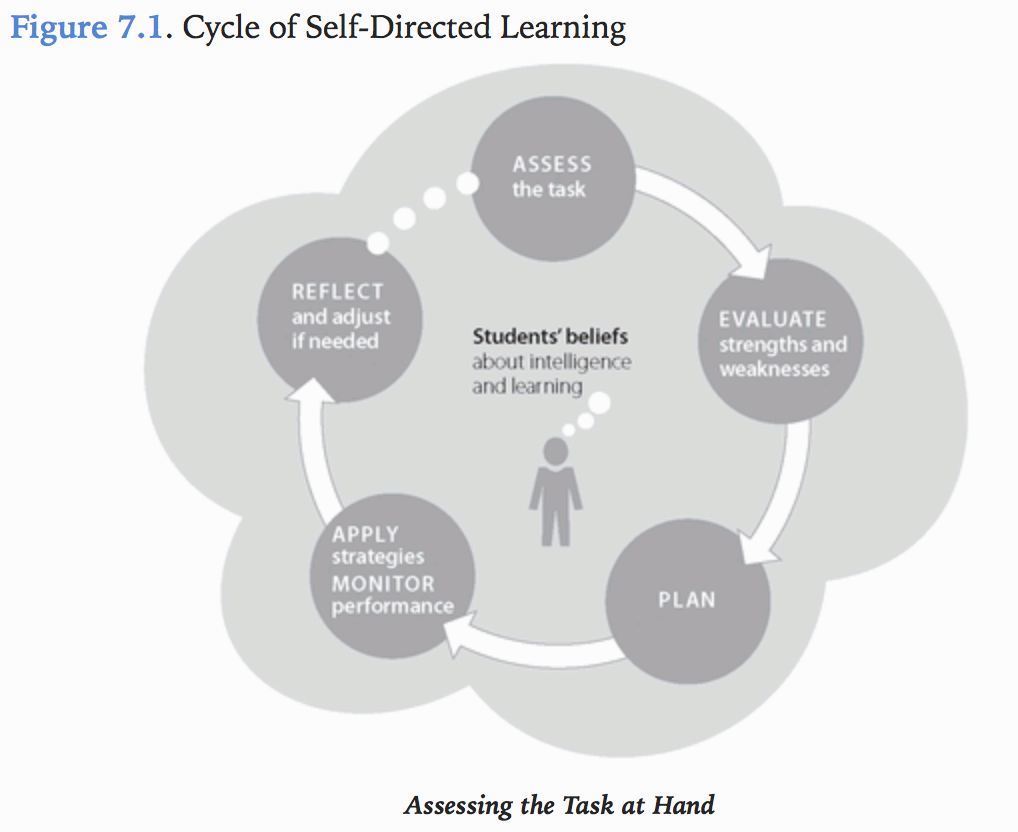
- Research finding:
- Metacognition is not used by students (or taught by the teachers)
- Strategies:
- Assess
- Be More Explicit Than You May Think Necessary
- Tell Students What You Do Not Want
- Check Students’ Understanding of the Task
-
Provide Performance Criteria with the Assignment
- Evaluate
-
Give Early, Performance-Based Assessments
-
Provide Opportunities for Self-Assessment
-
- Planning
-
Have Students Implement a Plan That You Provide
-
Have Students Create Their Own Plan When
-
Make Planning the Central Goal of the Assignment
-
- Apply & Monitor
-
Provide Simple Heuristics for Self-Correction
-
Have Students Do Guided Self Assessments
-
Require Students to Reflect on and Annotate Their Own Work
-
Use Peer Review/Reader Response
-
- Reflect
- Provide Activities That Require Students to Reflect on
- Prompt Students to Analyze the Effectiveness of Their Study Skills
- Present Multiple Strategies
- Create Assignments That Focus on Strategizing Rather Than Implementation
- Student’s beliefs
- Address Students’ Beliefs About Learning Directly
- Broaden Students’ Understanding of Learning Students
- Help Students Set Realistic Expectations
- Metacognition
- Modeling Your Metacognitive Processes
- Scaffold Students in Their Metacognitive Processes
- Assess
Engineering Education – Week 8.1 – Reading Notes
Ambrose, 2007, Chapter 3: “What Factors Motivate Students to Learn?”
- Motivation -> towards a goal
- Subjective: values of the goals
- Expectancies: what do you expect out of it
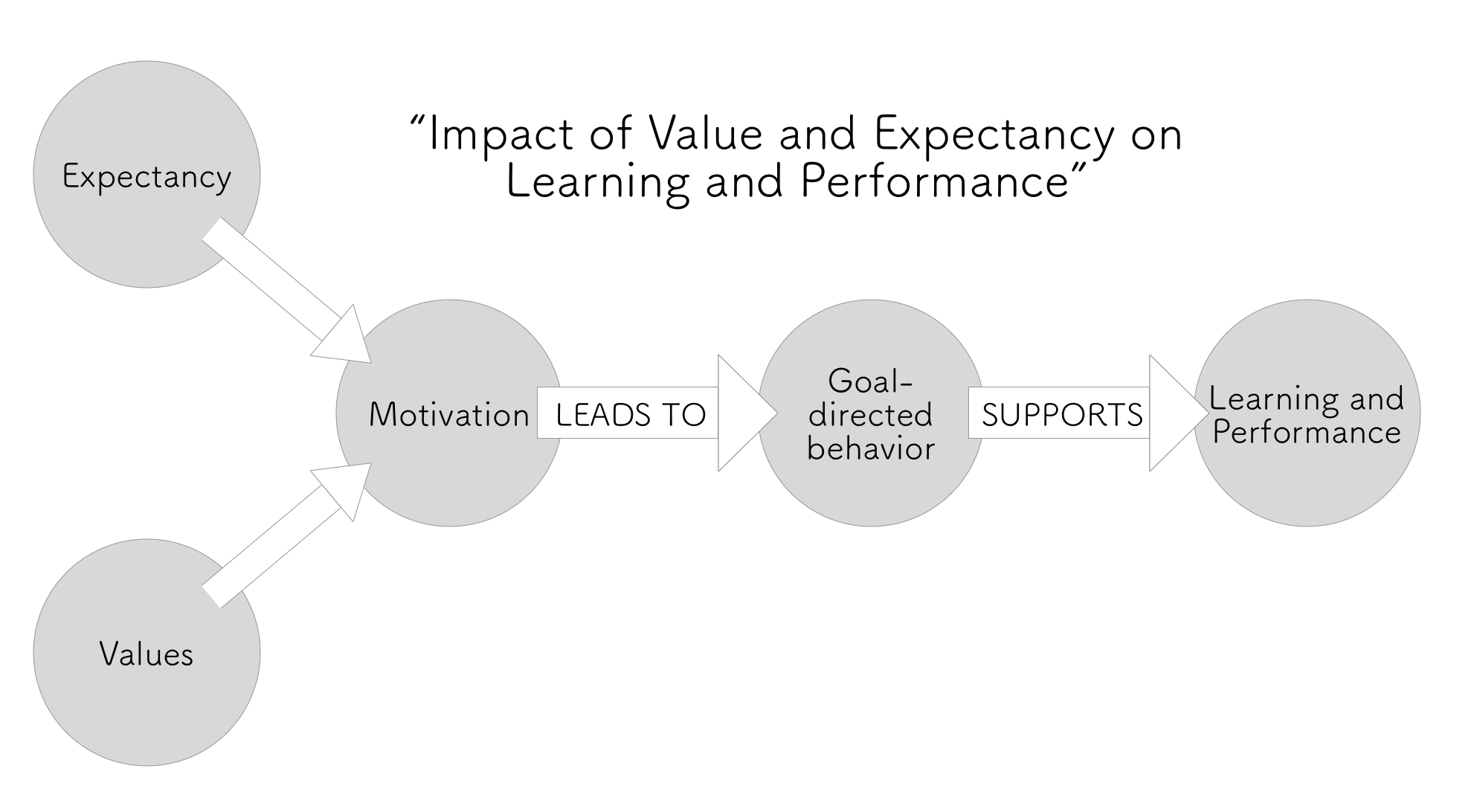
- Goals
- Multiple goals are usually in operation simultaneously
- Conflicting, simultaneous, and even synergic goals – potentially reinforcing
- Performance goals
- “Performance goals involve protecting a desired self-image and projecting a positive reputation and public persona”
- Two kinds
- Performance-approach goals: focus on attaining competence
- Performance-avoidant goals: focus on avoiding incompetence
- Learning goals
- Produce deeper understanding
- Work-avoidant goals
- Finish as fast as possible with minimum effort possible
- Affective goals
- Social goals
- Multiple goals are usually in operation simultaneously
- Values
- Attainment value
- Pleasure of getting there, making it to the next level
- Intrinsic value / motivation
- Do it for the sake of doing it
- Instrumental value
- Extrinsic rewards
- Attainment value
- Expectancies
- Outcome expectancies
- Positive or negative expectation of outcome
- Efficacy expectancies
- Belief of own’s capability of reaching the expected outcome
- Students attribution to success
- More likely to succeed when
- Internal causes (talents, ability)
- Controllable (effort, persistence)
- Less likely to succeed when
- External causes (easy task)
- Uncontrollable causes (luck)
- More likely to succeed when
- Outcome expectancies
- Context / environment
- Supportive environment + values + efficacy expectancies
- “Thus, our framework for understanding motivation suggests that if a goal is valued and expectancies for success are positive and the environment is perceived to be supportive, motivation will be highest.”
- Supportive environment + values + efficacy expectancies
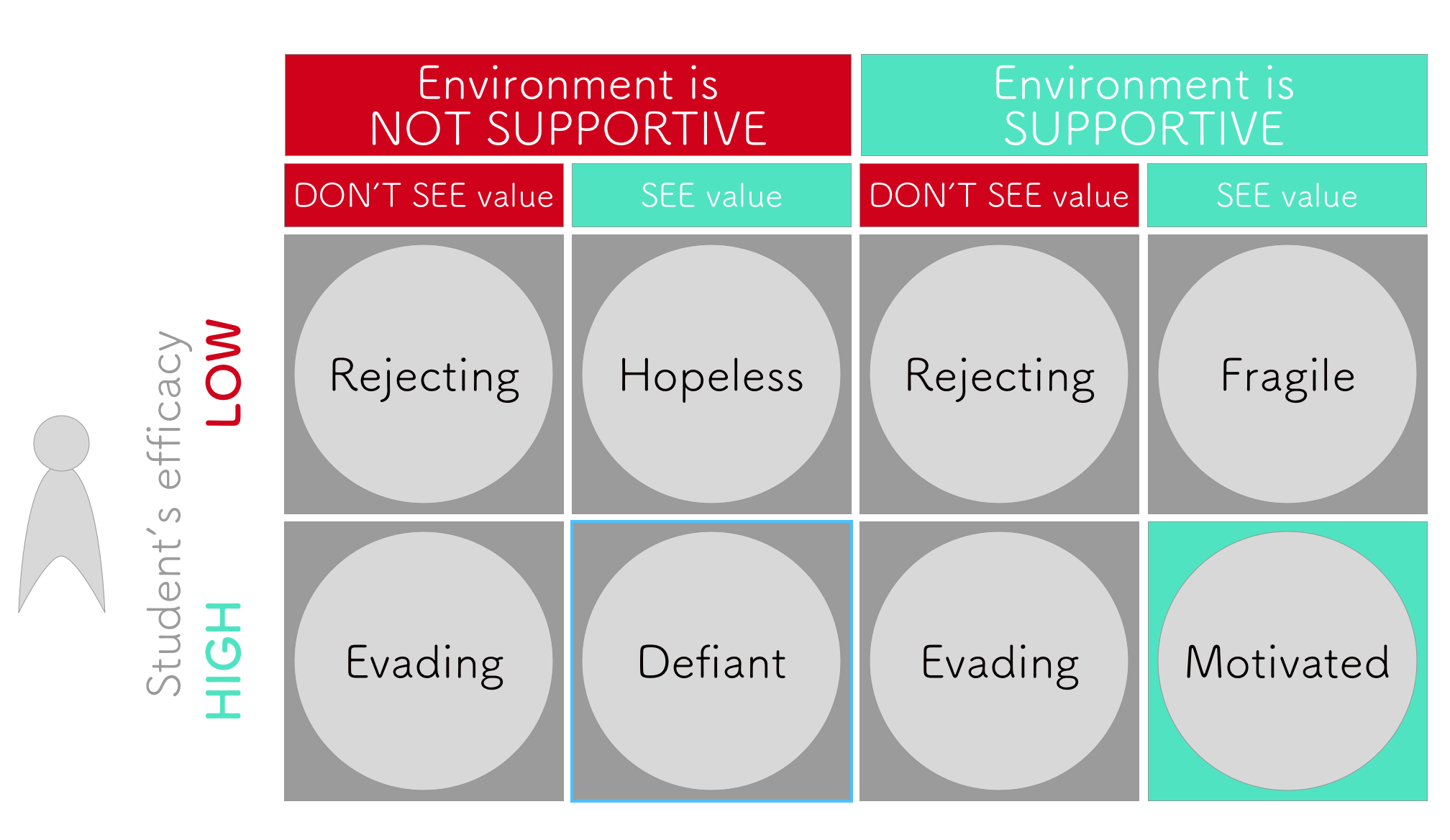
- Strategies
- Establish Value
- Connect material to student’s interests
- Provide authentic, real world tasks
- Show relevance to student’s current academic lives
- Demonstrate the relevance of higher-level skills
- Identify and reward what you value
- Show your own passion and enthusiasm about the discipline
- Positive Expectancies
- Ensure alignment of objectives, assessments, and instructional strategies
- Proper level of challenge
- Early success opportunities
- Articulate expectations
- Provide rubrics
- Targeted feedback
- Be fair
- Educate students about the ways we explain success and failure
- Describe effective strategies
- Provide flexibility and control
- Give students an opportunity to reflect
- Establish Value
BJ Fogg, 2009, “A Behavior Model for Persuasive Design”
- The Fogg Behavior Model (FBM)
- For a person to perform a target behavior they must:
- Be sufficiently motivated
- Have the ability to perform the behavior
- Be triggered to perform the behavior
- For a person to perform a target behavior they must:

- Core Motivators
- Pleasure / Pain
- Hope / Fear
- Social Acceptance / Rejection
- Elements of Simplicity
- Time
- Money
- Physical effort
- Brain cycles
- Social deviance
- Non-routine
- Trigger types
- Spark as a trigger
- Facilitator as a trigger
- Signal as a trigger
BJ Fogg, 2009, “The Behavior Grid: 35 Ways Behavior Can Change”
- Behavior Grid
- How to study and design persuasive technologies
- Horizontal axis
- Types of behavior change
- Vertical axis
- Schedule
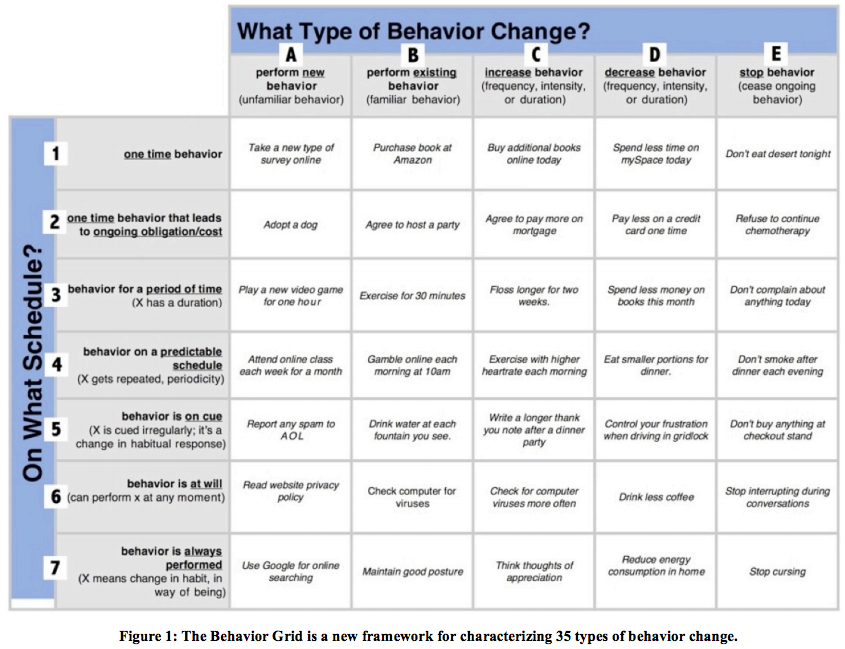
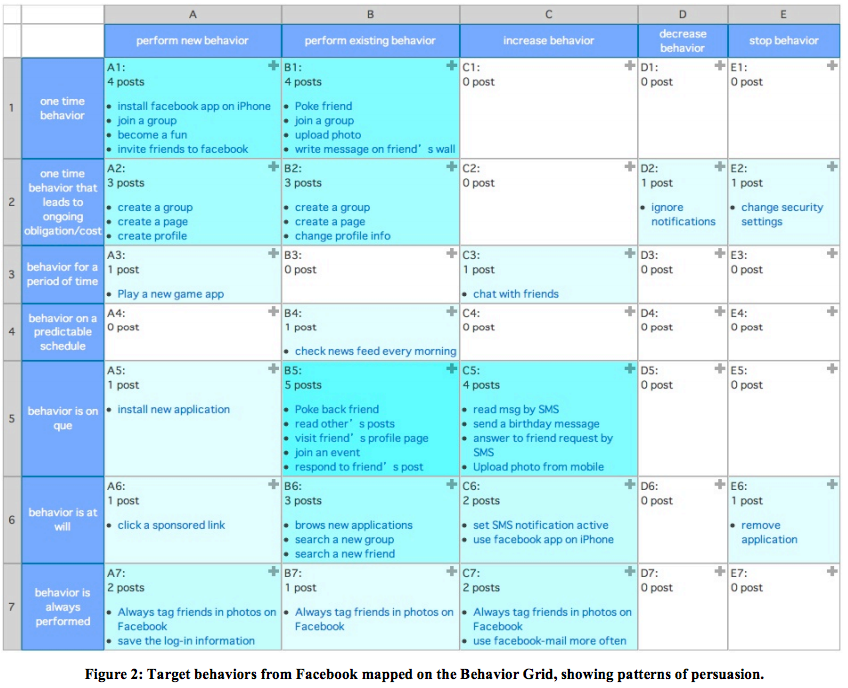
Engineering Education – Week 6&7 Assignments
Finally catching up with the homework and blog posts… here are the assignments for the last 2 weeks:
EdTech Game Critique Assignment
Empirical cognitive task analysis
Learning Outcomes
Assessment
Readings
Jan L. Plass, Bruce D. Homer & Charles K. Kinzer (2015) Foundations of Game-Based Learning, Educational Psychologist, 50:4, 258-283
Response:
I highly appreciated the reading in the sense that it does not claim to have found a holistic and generalizable theory or framework for game-based learning. It comprehensively analyzes the several aspects or considerations one takes (or should take) into account when designing a game-based learning experience, and concludes that no single approach is the most effective or essential. It also states that when designing, one can use several learning theories and several game design aspects to enhance the experience.
“In this article we argued that the integrated viewpoints of cognitive, motivational, affective, and sociocultural perspectives are necessary for both game design and game research in order to fully capture what games have to offer for learning.” (Plass et al, 2015)
I particularly enjoyed the definition of gamification which reduces it to a gimmicky buzz-word. Like most buzz-words, it is over and incorrectly utilized – with the best intentions of course – but creating a false sense that any process or interaction can be magically transformed into a game and thus increase customer satisfaction, retention, or engagement.
“What exactly is meant by gamification varies widely, but one of its defining qualities is that it involves the use of game elements, such as incentive systems, to motivate players to engage in a task they otherwise would not find attractive.” (Plass et al, 2015)
“Consider as an example the gamification of math homework, which may involve giving learners points and stars for the completion of existing activities that they con- sider boring. Game-based learning of the same math topic, on the other hand, even though it may also include points and stars, would involve redesigning the homework activi- ties, using artificial conflict and rules of play, to make them more interesting and engaging.” (Plass et al, 2015)
Ambrose, Chapter 6 (“Why Do Student Development and Course Climate Matter for Student Learning?”)
Response:
This passage only reinforces the notion that being a classroom teacher is one of the most complex and demanding professions around. It really is an art to be able to balance delivering the content in a pedagogically sensible way and manage an entire classroom with very different individuals with particular needs and different interests, motivations, and previous knowledge. There is no silver bullet, but it does not mean we have to stop trying.
Engineering Education – Week 6.1 – Reading Notes
Reading:
LOFT Process Guides: Define Phase. Techniques: Writing Learning outcomes
Summary:
Notes:
- Creating and online course – tips:
- Establish a community of practice
- Start small
- Start early
- Gather your team
- Gear up
- Be aware of legal issues
- Vary your approach
- Use a style guide
- Learning objectives
- “Learning objectives describe the knowledge and skills we want students to gain from our instruction. Learning objectives are used to provide a framework for selecting and organizing course content and learning activities, guide decisions about assessment and evaluation methods, and give learners information for directing their learning efforts and monitoring their progress.
An assessment is an exercise whose output can be used to measure the attainment of a learning objective. Assessments can serve two purposes: evaluate student performance and foster learning.”
- Main purposes of Learning Objectives
- Communicate our intentions clearly to students and to colleagues.
- Provide a framework for selecting and organizing course content.
- Guide decisions about assessment and evaluation methods.
- Provide a framework for selecting appropriate teaching and learning activities.
- Give students information for directing their learning efforts and monitoring their own progress.
- Goals vs. Objectives + Topics List
- Goals are broader and describe the final state:
- “The end toward which effort is directed”
- Objectives precisely define observable skills and knowledge the audience must demonstrate to show achievement towards the final goal
- “Something toward which effort is directed”
- Topics list is simply a list of content that will be looked at within a course
- Goals are broader and describe the final state:
- Characteristics of an Effective Learning Objective
- ABCD approach
- “The audience is the learner who will demonstrate the behavior under specified conditions and to an acceptable degree.”
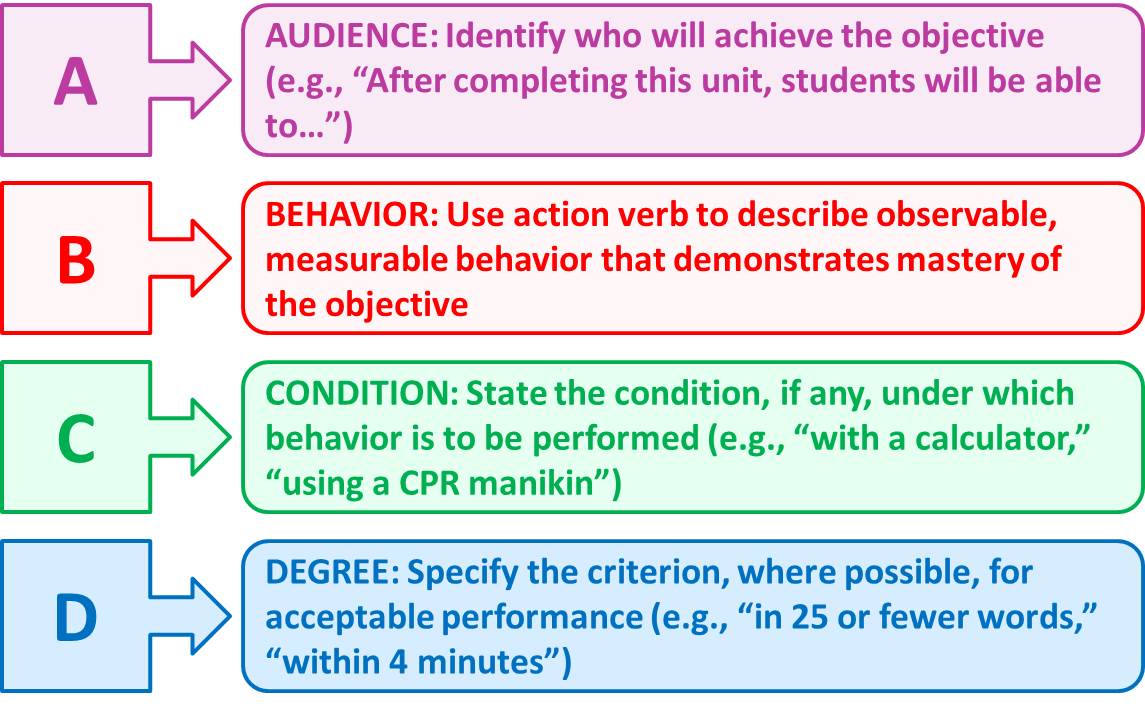
- Not every learning objective must include a condition or a degree
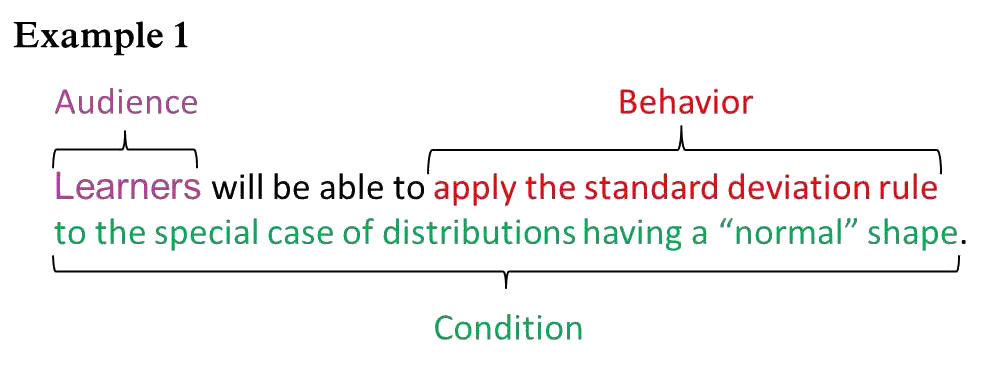
- The order is also not important
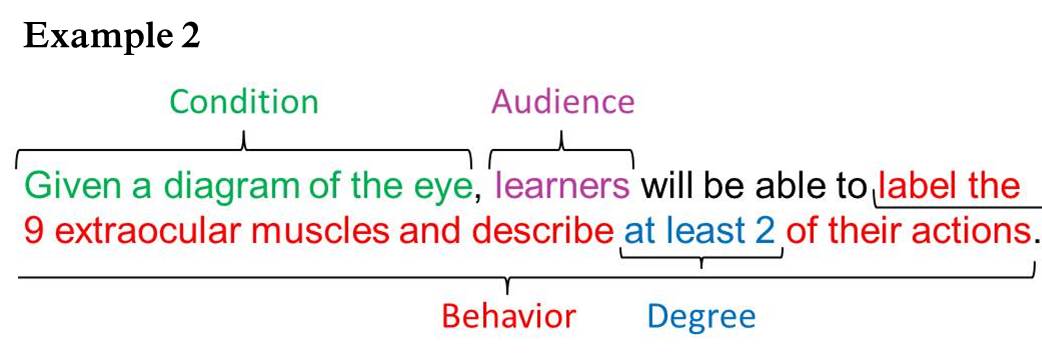
- Audience
- The better you understand your audience the more effective your learning objective, and thus your course might be
- Prior Knowledge:
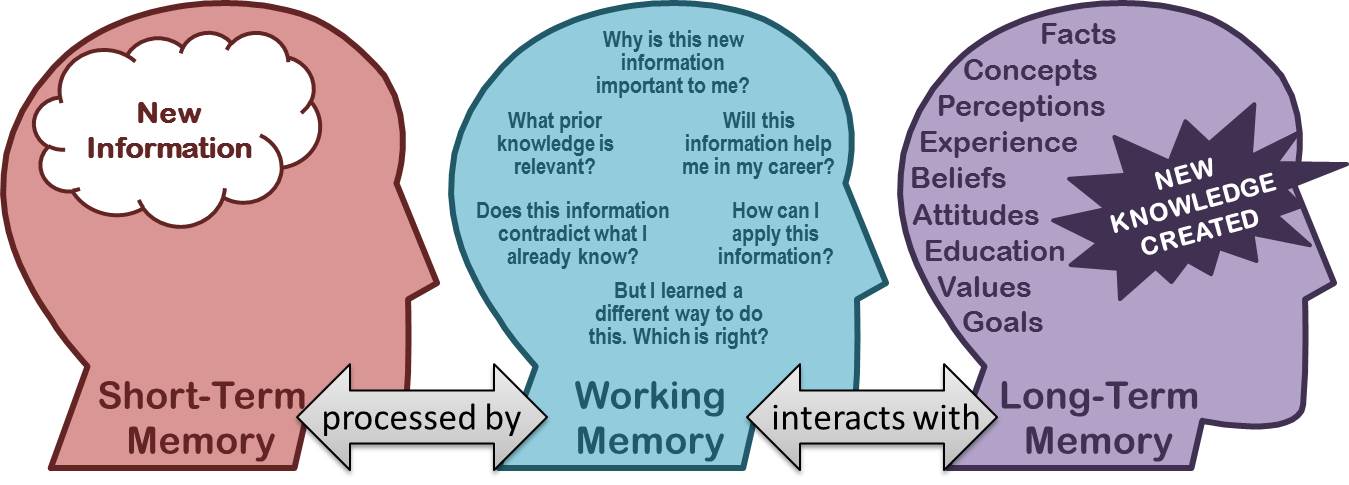
- Learning objectives are an important tool for the instructor, but most important for the students
- Teacher- vs. Student-centric learning objectives
- Behavior
- An observable and/or measurable action
- Bloom’s Taxonomy’s domains
- KSA: Knowledge, Skills, Attitude
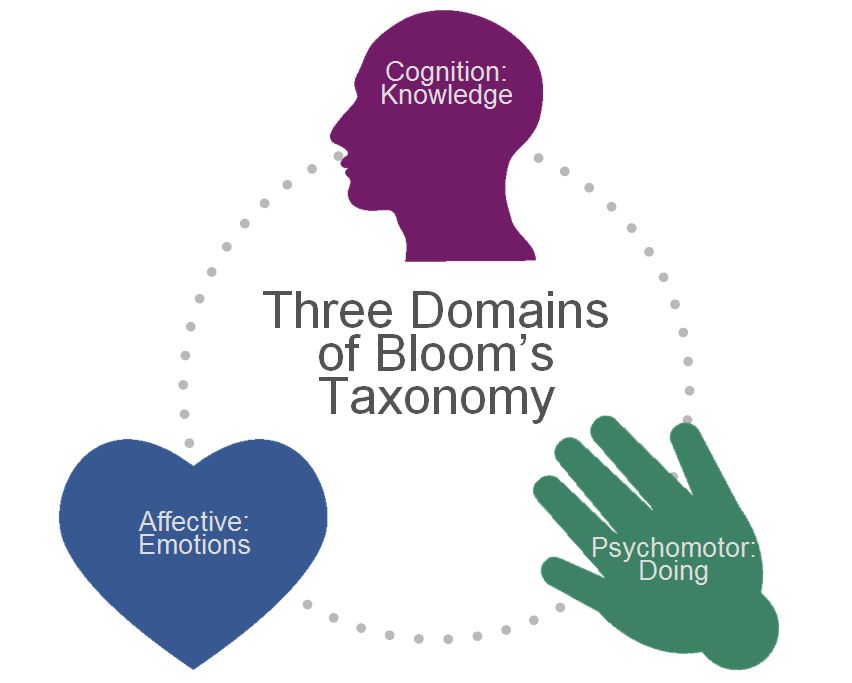
- Cognitive domain:
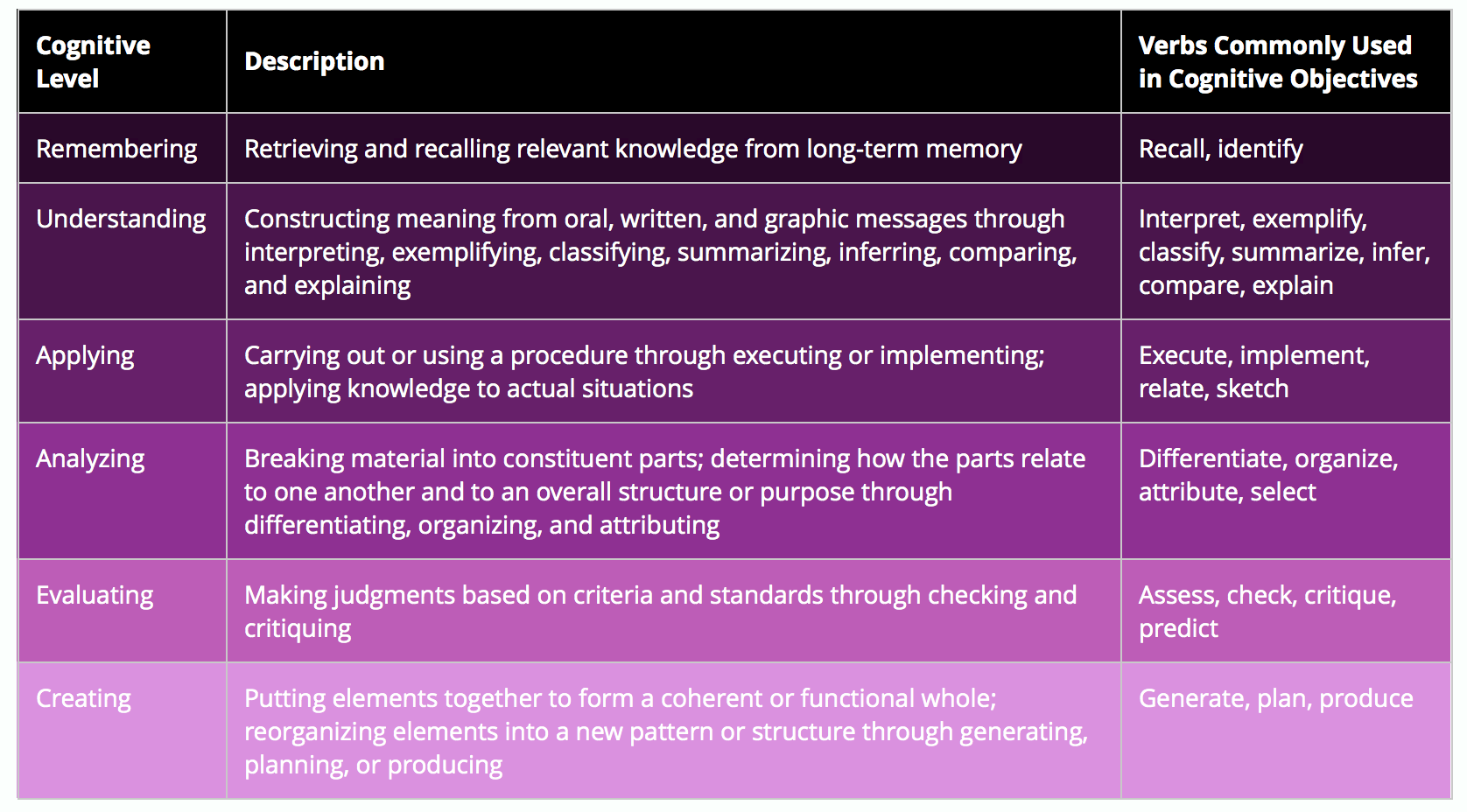
- Examples:
- Remember
- Students will be able to define mitosis.
- Students will be able to name the phases of mitosis.
- Understand
- Students will be able to explain the process of mitosis.
- Students will be able to summarize the central limit theorem.
- Apply
- Students will be able to sketch the progression of mitosis in a five-stage diagram.
- Students will relate the law of supply and demand to the costs of health care.
- Analyze
- Students will be able to compare and contrast classical conditioning and operant conditioning.
- Students will be able to select a healthy exercise plan for an overweight child.
- Evaluate
- Students will be able to evaluate the George W. Bush administration’s actions in conducting the 2003 U.S.-led invasion of Iraq without declaring war.
- Students will be able to assess current artificial intelligence technology and describe its potential applications in health care.
- Create
- Students will be able to compose a villanelle (a poem of 19 lines with two refrains and two repeating rhymes).
- Students will be able to create a three-dimensional bump map in Adobe Photoshop.
- Remember
- Examples:
- Knowledge domain
- Factual: Knowledge of terminology and of specific details and elements
- Conceptual: Knowledge of classifications and categories; principles and generalizations; theories, models, and structures
- Procedural: Knowledge of subject-specific skills and algorithms, techniques, and methods; criteria for determining when to use appropriate procedures
- Metacognitive: Strategic knowledge; knowledge about cognitive tasks, including appropriate contextual and conditional knowledge; self-knowledge
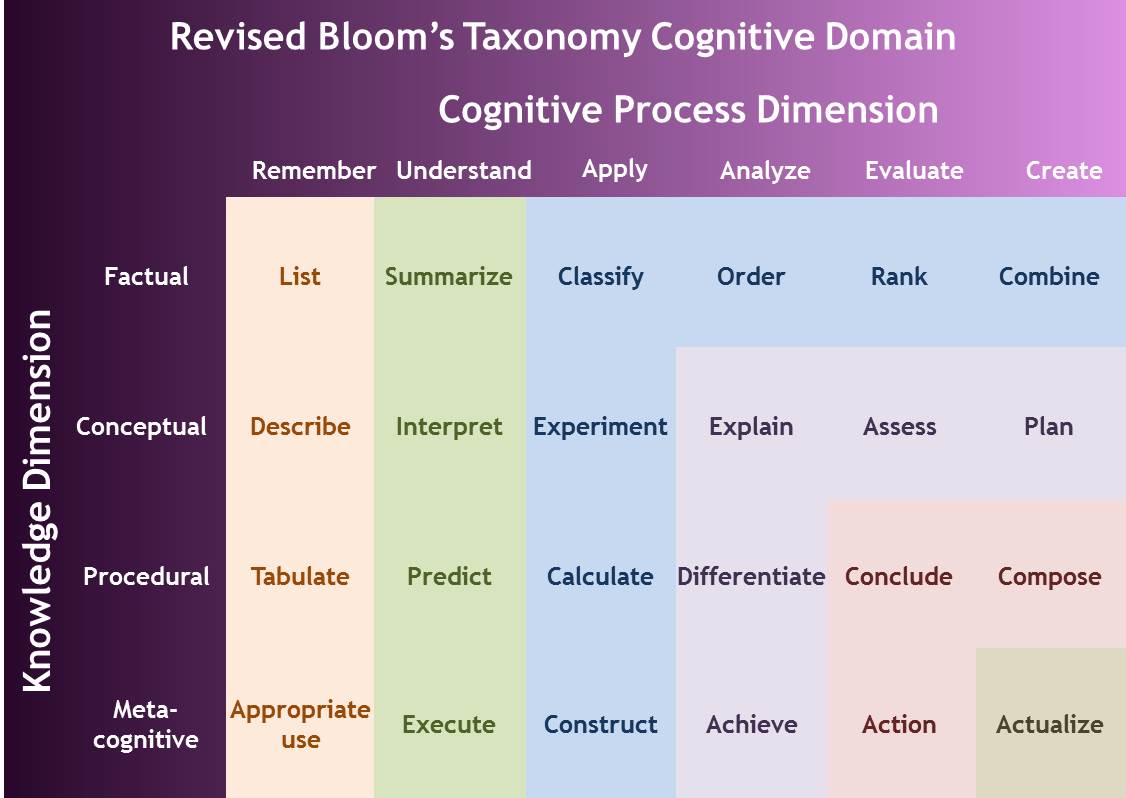
- Psychomotor domain

- Affective domain
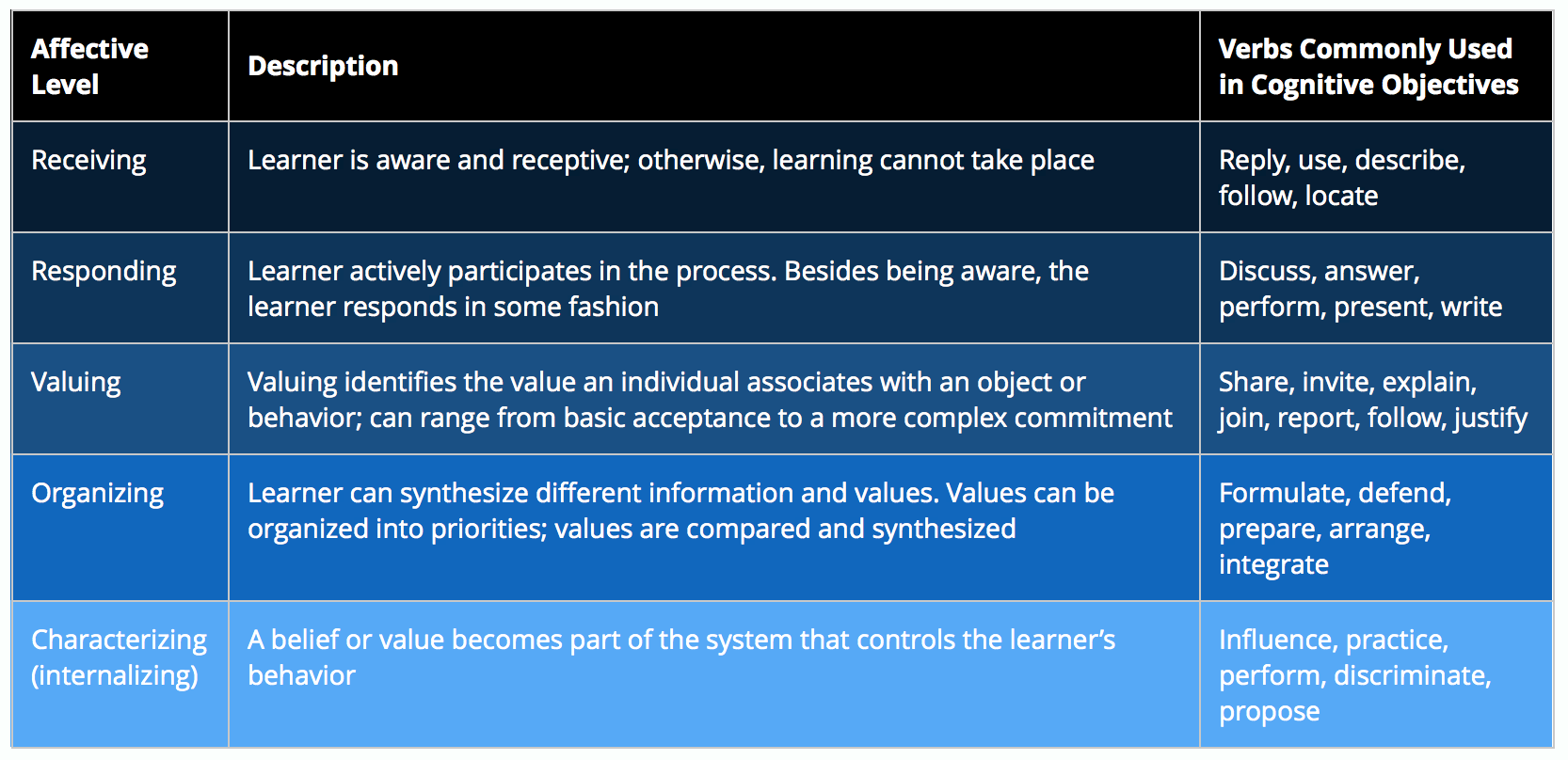
- Condition
- What is it?
- What a student may or may not use to demonstrate mastery of the objective
- The circumstance under which the behavior is to be performed.
- What is it?
- Degree
- Sometimes the degree is implied: “without errors” for example
- “The audience is the learner who will demonstrate the behavior under specified conditions and to an acceptable degree.”
- Scope and size
- Can be broad and all encompassing or small and specific
- Can be for the entire course and can be for a specific module
- Questions to reflect upon when creating a learning objective
- Too big
- Do your objectives sound generic, as though they could appear on a syllabus in almost any course or discipline?
-
Could your objectives describe an entire curriculum?
- Too small
-
Do your objectives contain repetition and overlap?
- Do your objectives read like the task specifications for an assignment?
-
- Too big
- Developing learning objectives is
- A time-consuming process: It takes careful thought and revision to produce a polished set of learning objectives. Allow yourself plenty of time for this task.
- An iterative process: Learning objectives provide the foundation for designing your course, but once they are written, expect to revise and refine the objectives to keep them in alignment with your content, activities, and assessments.
- A flexible process: You can find helpful tips and guidelines for developing effective learning objectives, but you will not find rigid rules. You (and your team if you work with one) must be flexible as you create objectives that work best for your course.
- ABCD approach
- “Learning objectives describe the knowledge and skills we want students to gain from our instruction. Learning objectives are used to provide a framework for selecting and organizing course content and learning activities, guide decisions about assessment and evaluation methods, and give learners information for directing their learning efforts and monitoring their progress.
Engineering Education – Week 5.2 – Class Notes

Great class today with guest speaker – NYU professor Jan L. Plass – the author of this week’s reading on the foundations of Game-Based Learning.
The biggest takeaway was the distinction between a game-based learning experience vs. gamification. Gamification is a “buzz word” that people love to use or think of as a way to engage their users, to make their product more appealing, or effective. In reality, it’s a simple way of adding game-based features such as points, badges, or reward systems…
Engineering Education – Week 5.2 – Reading Notes
Reading:
Jan L. Plass, Bruce D. Homer & Charles K. Kinzer (2015) Foundations of Game-Based Learning, Educational Psychologist, 50:4, 258-283
Summary:
I highly appreciated the reading in the sense that it does not claim to have found a holistic and generalizable theory or framework for game-based learning. It comprehensively analyzes the several aspects or considerations one takes (or should take) into account when designing a game-based learning experience, and concludes that no single approach is the most effective or essential. It also states that when designing, one can use several learning theories and several game design aspects to enhance the experience.
“In this article we argued that the integrated viewpoints of cognitive, motivational, affective, and sociocultural perspectives are necessary for both game design and game research in order to fully capture what games have to offer for learning.” (Plass et al, 2015)
I particularly enjoyed the definition of gamification which reduces it to a gimmicky buzz-word. Like most buzz-words, it is over and incorrectly utilized – with the best intentions of course – but creating a false sense that any process or interaction can be magically transformed into a game and thus increase customer satisfaction, retention, or engagement.
“What exactly is meant by gamification varies widely, but one of its defining qualities is that it involves the use of game elements, such as incentive systems, to motivate players to engage in a task they otherwise would not find attractive.” (Plass et al, 2015)
“Consider as an example the gamification of math homework, which may involve giving learners points and stars for the completion of existing activities that they con- sider boring. Game-based learning of the same math topic, on the other hand, even though it may also include points and stars, would involve redesigning the homework activi- ties, using artificial conflict and rules of play, to make them more interesting and engaging.” (Plass et al, 2015)
Notes:
- Game-based learning
- Type of game with defined learning outcomes
- Play and cognitive development
- Piaget and Vygotsky already stated that play is integral to children’s cognitive development
- The arguments
- Motivation
- Player engagement
- Adaptivity
- Graceful failure
- Model of Game Based Learning
- Games do not use a single theory, but a combination of a few
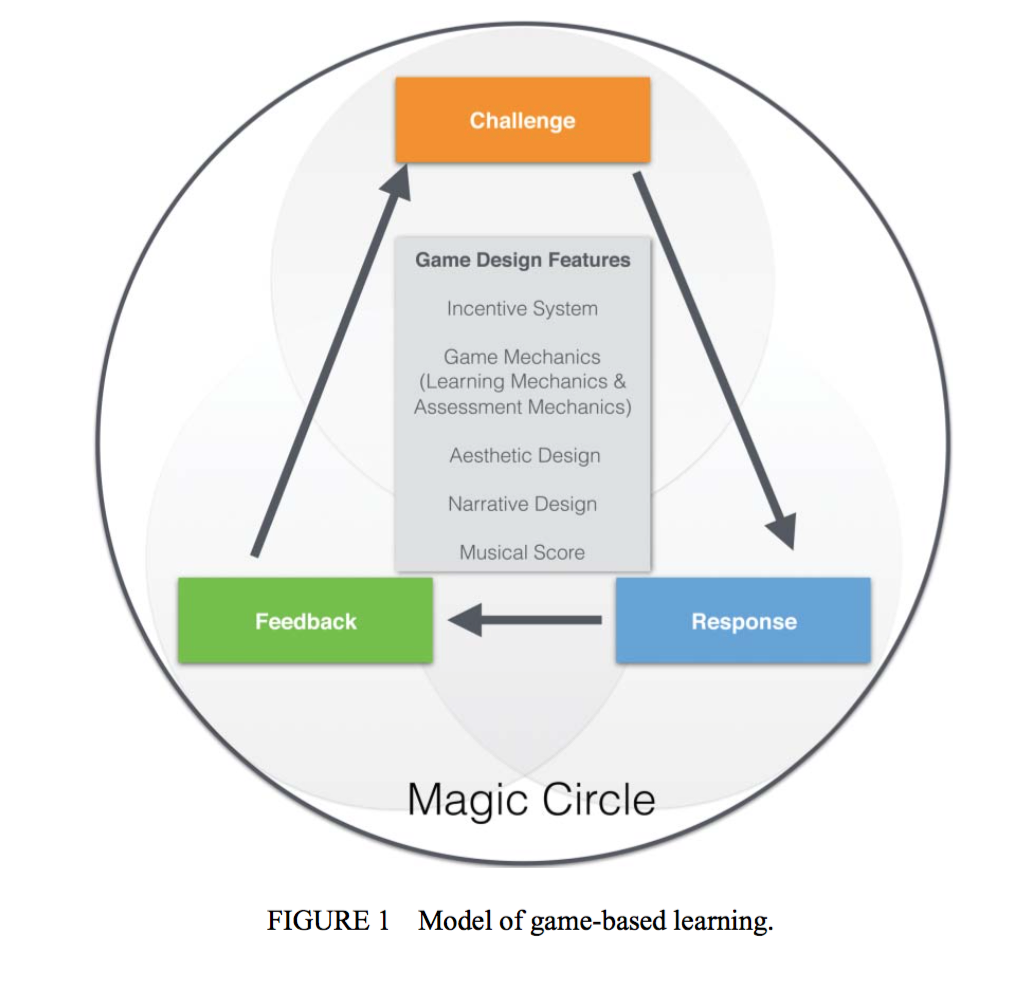
- Elements of Game Design for Learning
- Game Mechanics
- Visual Aesthetic Design
- Narrative Design
- Incentive System
- Musical Score
- Content and Skills
- Preparation of future learning
- Teach new knowledge and skill
- Practice and reinforce existing knowledge and skills
- Develop 21st century skills
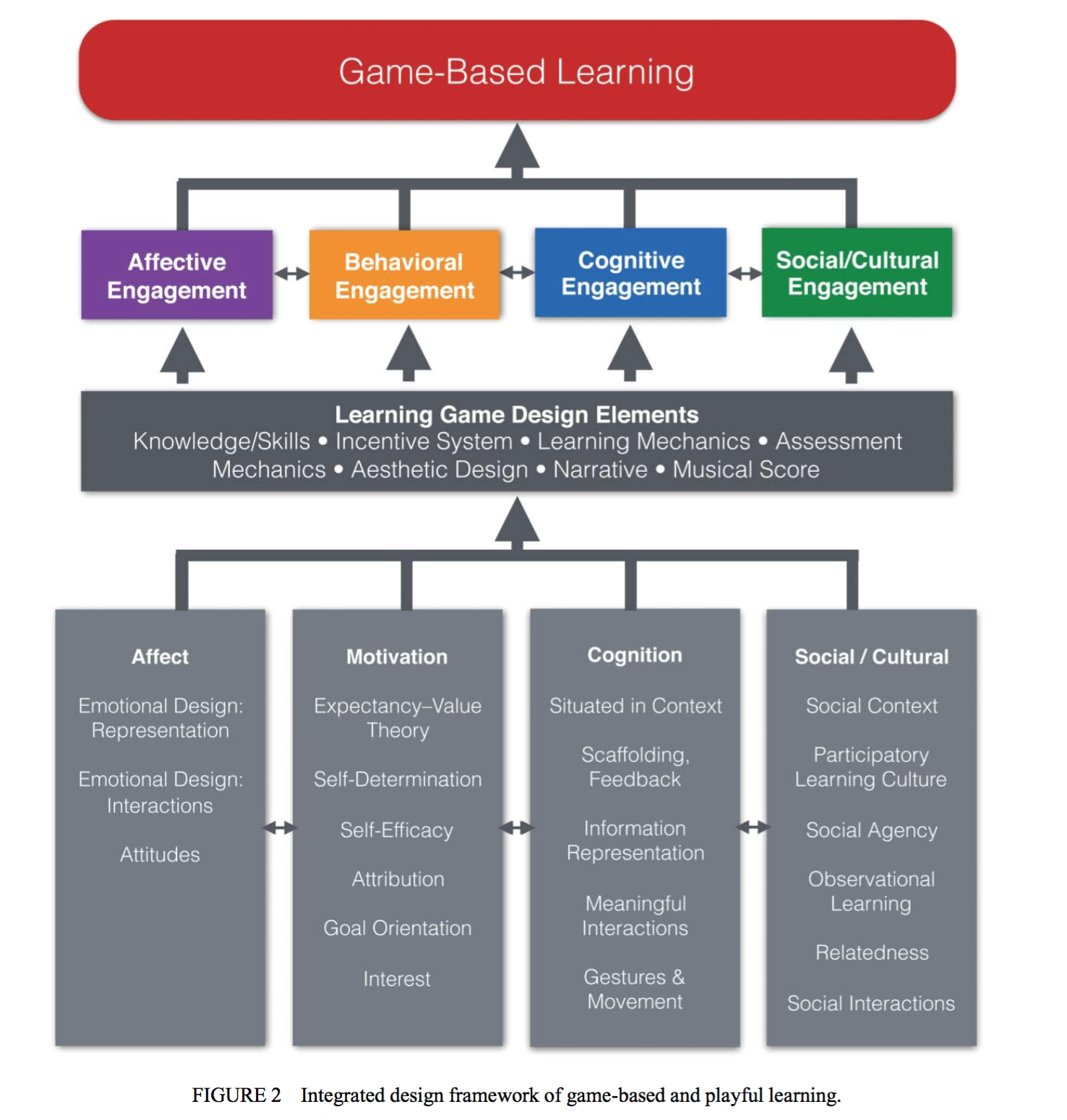
- Cognitive Foundations of Game-Based Learning
- Situatedness
- Transfer of learning
- Scaffolding and relevant feedback
- Dynamic assessment
- Information design: representation of information
- Interaction design: learning mechanics
- Gestures and Movement
- Motivational Foundation of Game-Based Learning
- Intrinsic motivation
- Values and interests
- Achievement-related goals
- Affective Foundation of Game-Based Learning
- Emotional design
- Anything in the game that will provoke emotions: design elements, sounds, storylines, and so on…
- “Research also shows that affective tutors that respond to players’ emotions can enhance learning. However, it still needs to be investigated what kinds of emotions best facilitate learning in general, and what kinds of emotions learners experience over time will optimize their emotional engagement and, as a result, their cognitive engagement.”
- Emotional design
- Sociocultural Foundation of Game-Based Learning
- Very hard to relate social and cultural factors in design with learning outcomes as they are an integral part of the creation process and its subsequent use.
- “The goal of learning designs that focus on social and cultural aspects of learning relate to how learners can participate in groups, use collective knowledge to meet goals, relate learning to aspects of cultural norms and identities, and use social and cultural influences as motivators for learning through features that are contained within immediate and more distributed game play.”
- Activity Theory
- Social Context of Learning
- Participatory Learning Culture
- Social Aspects of Agency
- Observational Learning
- Relatedness and Self Perception
- Social Interaction Design
- “In much the same way as was discussed in the sections relating to affect and motivation, however, although we know that sociocultural factors influence learning, establishing sociocultural design patterns that directly relate to learning across a broad range of games may not yet be possible.”
- Very hard to relate social and cultural factors in design with learning outcomes as they are an integral part of the creation process and its subsequent use.
Engineering Education – Week 5.1 – Class Notes
Ok class – talking about the readings and more about what Benchmark Tasks are and what a Cognitive task analysis entails. A little confusing as to how to translate this technique into my very ‘meta’ project but let’s do it 😉
Engineering Education – Week 5.1 – Reading Notes
Reading:
Ambrose, S. A. (2010). How learning works: Seven research-based principles for smart teaching. San Francisco, CA: Jossey-Bass.
Notes:
Chapter 4 – “How Do Students Develop Mastery?”
- A Sum of Their Parts
- Students perform better on individual projects rather than in group projects
- May not poses the team work skills
- “Shouldn’t They Know This by Now?”
- Seems like the students do not learn anything from previous courses!
- May never have put previous knowledge into practice
- Whole is greater than the sum of the parts
- “Principle: To develop mastery, students must acquire component skills, practice integrating them, and know when to apply what they have learned.”
- Expertise – liability for teaching sometimes
- Elements of Mastery
- Acquire – direct instruction
- Practice – interact with content
- When to Apply – project based learning
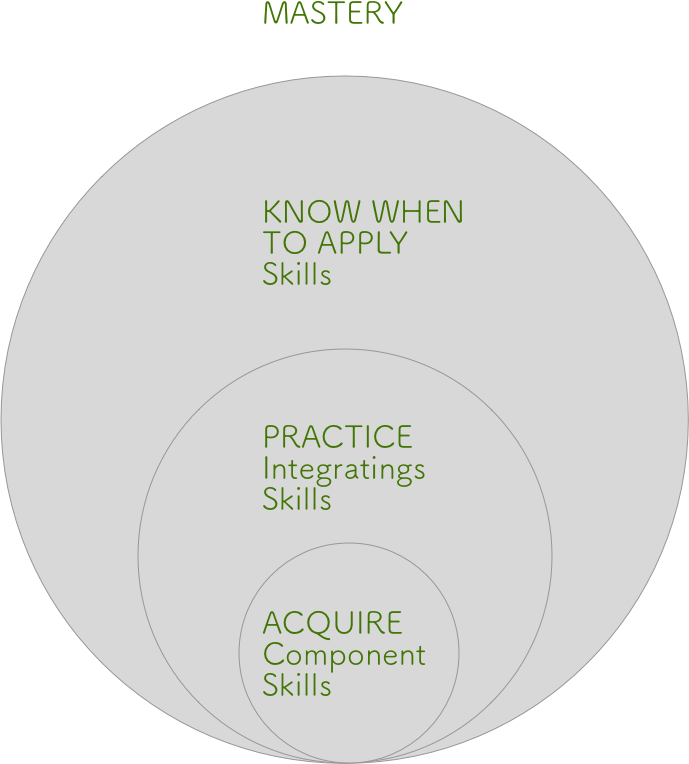
- Stages in the Development of Mastery
- Unconscious Incompetence
- Does not recognize what needs to be learned. Do not know what they do not know.
- Conscious Incompetence
- Know what needs to be learned
- Conscious Competence
- Still have to think about what they’ve mastered
- Unconscious Competence
- They just do it instinctively. Forget how much they know.
- Unconscious Incompetence

- Expert’s Blind Spot
- “When expert instructors are blind to the learning needs of novice students, it is known as expert blind spot (Nickerson, 1999; Hinds, 1999; Nathan & Koedinger, 2000; Nathan & Petrosino, 2003). To get a sense of the effect of expert blind spot on students, consider how master chefs might instruct novice cooks to “sauté the vegetables until they are done,” “cook until the sauce is a good consistency,” or “add spices to taste.”” (Ambrose, 2010)
- “instructors must be able to “unpack” or decompose complex tasks.” (Ambrose, 2010)
- Problem solving strategies, not rote procedural tasks
- Scaffolding (worked-example effect)
- Reduce student’s cognitive load by providing some help and thus freeing up resources for learning
- Transfer
- Apply skills learned in one context onto a novel context
- Near -> Far Transfer (the central goal of education!?)
- Similar -> Dissimilar contexts
- Extremely hard. Research shows very little evidence.
- “a) transfer occurs neither often nor automatically, and (b) the more dissimilar the learning and transfer contexts, the less likely successful transfer will occur. ” (Ambrose, 2010)
- Overspecificity – context dependence
- Associate skill with context too tightly
- Mason Spencer & Weisberg, 1986; Perfetto, Bransford, & Franks, 1983
- Some positive research
- Throwing darts onto a target under water
- When presented with the concepts of refraction, students did better
- “Divide and conquer” in a military example
- Only were able to apply strategy to a medical problem when explicitly told to do so.
- Throwing darts onto a target under water
- Strategies to “teach for transfer”
- Decompose complex tasks
- Combine and integrate skills
- Learn to identify where to apply what they learned
- Techniques
- Push Past Your ® Expert Blind Spot
- “What would students have to know—or know how to do—in order to achieve what I am asking of them?”
- Enlist TAs or Graduate students for task decomposition
- You might have unconscious competence while they would have conscious competence making it clearer where further unpacking or decomposing complex tasks
- Talk to your colleagues
- Compare notes, research papers, oral presentations, or design projects.
- Enlist help from someone outside your discipline
- They will not have your expert blindspots and may add to your repertoire of teaching strategies.
- Explore available educational materials
- You may just find that other’s have already faced the same challenges you are facing
- Focus student’s attention on key aspects of the task
- Do not overload them cognitively with empty information
- Diagnose weak or missing component skills
- Evaluate previous knowledge early on to be able to adjust
- Provide isolated practice of weak or missing skills
- Create extra assignments and activities to supply deficits
- Give students practice to increase fluency
- Engage with the content to produce artifacts that will reinforce the link between theory and practice
- Temporarily constrain the scope of the task
- Use smaller tasks and build up into more complex tasks
- Explicitly include integration in your performance criteria
- Integration is a skill itself
- Discuss conditions of applicability
- Explicitly mention where you might apply the learnings
- Apply skills or knowledge in diverse contexts
- Use multiple cases to evidence transfer
- Generalize to larger principles
- Step back from the details to relate them to macro phenomena
- Use comparisons to identify deep features
- Surface features vs deep features
- Specify context and ask students to identify relevant skills or knowledge
- Give a case study and ask students to generate knowledge and skills appropriate for that context.
- Specify skills and knowledge and ask students to identify contexts in which they apply
- Students need to think where else could they apply what they’ve just learned.
- Provide prompts to relevant knowledge
- Create knowledge bridges: “Think back…”, “Remember we talked about…”
- Push Past Your ® Expert Blind Spot
Chapter 5 – “What Kinds of Practice and Feedback Enhance Learning?”
- Cases
- “When practice does not make perfect”
- Students may keep doing things the wrong way… maybe the problem is with the instruction and not the students
- If students do not posses the prerequisite skills or knowledge, very rarely they will be able to perform in any manner above the base.
- Have to allow for time and practice – cannot change the activity’s flavor until student’s get it…
- “They just do not listen!”
- Students are not always clear of what is expected of them. Must model by showing what quality work looks like.
- “When practice does not make perfect”
- Practice and feedback
- “Principle: Goal-directed practice coupled with targeted feedback are critical to learning.” (Ambrose, 2010)
- Characteristics of successful practice:
- Focuses on a specific goal or criterion for performance
- Deliberate practice towards goals
- If student is not clear on what the goal is, it is hard to achieve it.
- Targets an appropriate level of challenge relative to students’ current performance
- If the task is too hard, students will be overwhelmed and not be able to take away much from the task
- ZPD… has to be proximal
- Similar to balancing in video games: not too hard, not too easy
- Is of sufficient quantity and frequency to meet the performance criteria
- Time and quantity
- Focuses on a specific goal or criterion for performance
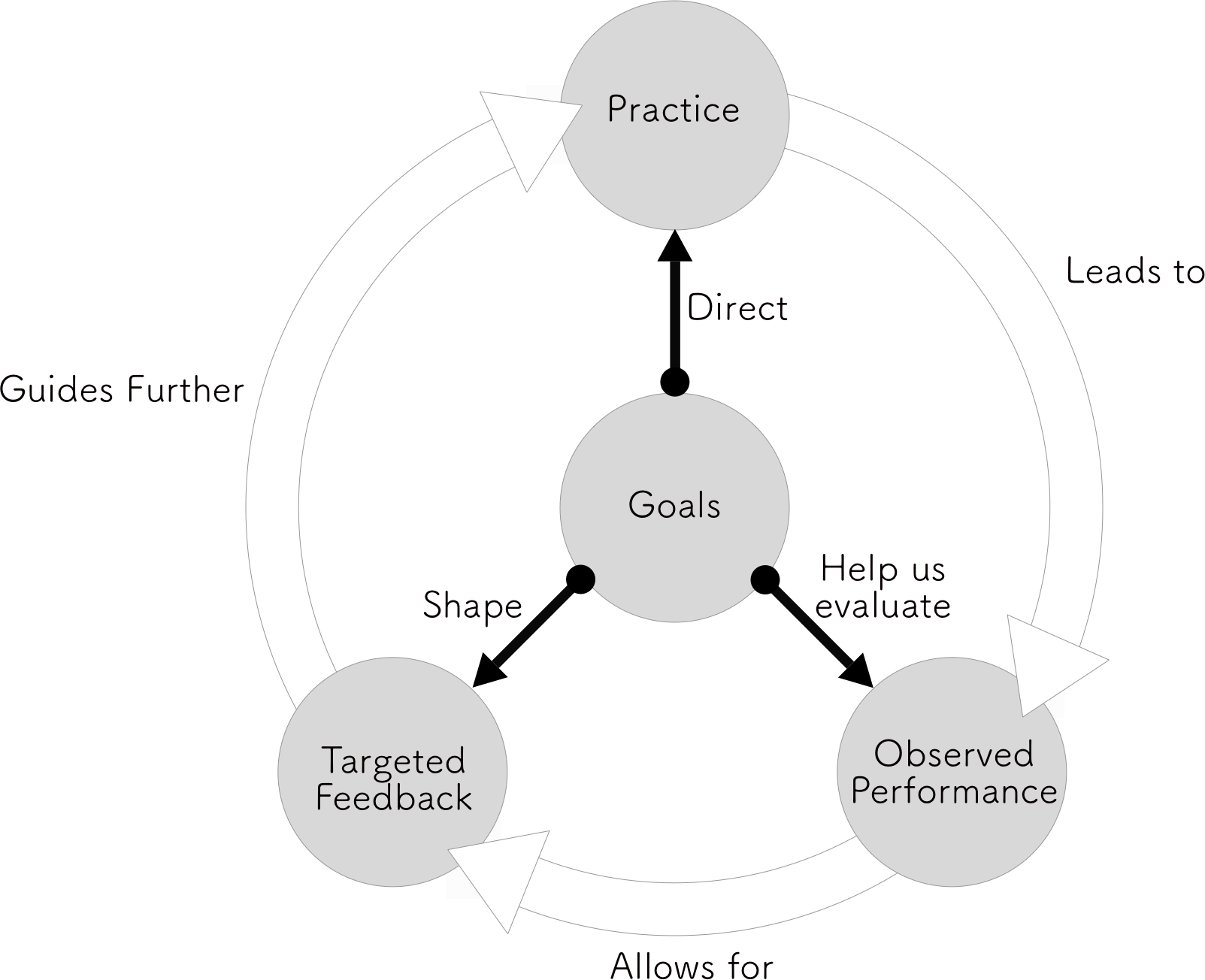
- “Overall, the implications of the body of research on practice are that to achieve the most effective learning, students need sufficient practice that is focused on a specific goal or set of goals and is at an appropriate level of challenge. ” (Ambrose, 2010)
- Goal-directed feedback + targeted feedback
- What they do or don’t understand
- Where their performance is
- How they should direct their efforts
- More formative, less summative feedback
- Don’t over do it though – let the student grapple with it for a bit
- Must consider how much time to give feedback to all and amount of time needed to process all the feedback by the students.
- Feedback must:
- Focus students on key concepts you want them to learn
- Time and frequency depends on when the student will be able to use it
- Linked to additional practice opportunities
- Goal Directed Practice strategies
- Assess previous knowledge to adjust challenge level
- Be explicit about goals in course material
- Use rubric with students to specify and communicate the performance criteria
- Provide multiple opportunities for practice
- Scaffold assignments
- Set expectations about practice
- Show what target performance is
- Show what you do not want
- Refine goals and performance criteria as the course progresses
- Targeted Feedback strategies
- Look for patterns or errors in student work
- Prioritize your feedback
- Balance strengths and weaknesses on your feedback
- Design frequent opportunities to give feedback
- Provide feedback at the group level
- Incorporate peer feedback
- Require students to specify how they used feedback in subsequent work